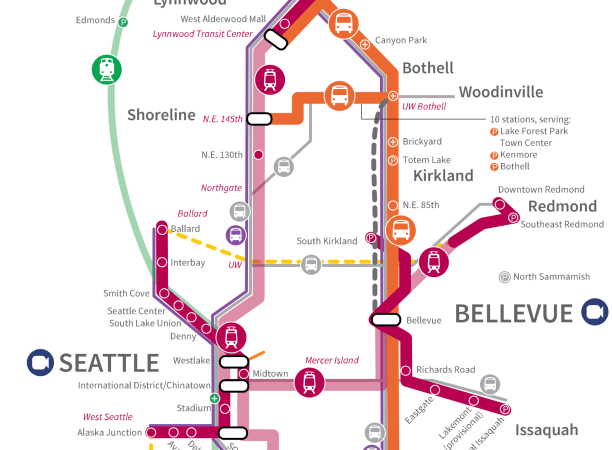No, we’re not entering a period of “untransit”
 ST3 concept map / soundtransit3.org
ST3 concept map / soundtransit3.orgDanny Westneat's latest column in The Seattle Times asks a bold question:
Why are we continuing with the same transit planning - such as for Sound Transit's future light-rail segments - without factoring that a third or more of the workforce may not be commuting to a downtown core, or commuting at all?
Westneat is knee-jerk reacting to Amazon's recent announcement that it plans to pause work on its Bellevue office expansion: a total of six towers encompassing some 3 million square feet. The implication is that if a corporate behemoth like Amazon can't be bothered to continue building office towers, then transit - as we know it - might as well be dead:
This sea change, if it continues, may cause cities over time to untransit" - to unwind their transit-oriented, spoke-and-hub development patterns, Stern predicts. Cities will stop concentrating on building dense housing near transit lines, she wrote, and shift to infrastructure to support remote work (such as municipal broadband, or small remote work" centers away from the old business core). Cities may adopt more mixed-use zoning everywhere to bring a taste of the old commercial downtown out to residential neighborhoods (where so many are now going" to work).
I'll first acknowledge what is true in this assessment. There is already broad consensus in the transit and urbanist community that the new normal for remote work will undoubtedly impact future land use: central business districts will no longer have a regular weekday swell" of workers. Super-tall office-only skyscrapers are likely a thing of the past. And mixed-use upzoning is undoubtedly on the planning menu for non-CBD neighborhoods.
What I find much more questionable is this notion that cities will stop concentrating on building dense housing near transit." I'm not sure there is a planner out there who actually believes this. Regardless how commute patterns change, expanding buildable TOD maximizes the return on transit investment. Housing and transit can never be divorced, whatever remote work world we live in. If anything, it's the massive suburban park-and-rides at outlying stations that should be converted into developable uses rather than sit empty.
Westneat furthers this line of argument by suggesting that remote work blunts the merits of continued Link expansion. I find this thinking to be bizarre - Link was not and never has been planned to be a commuter-centric system. If you look at a map of ST2 and ST3 extensions, it's clear that the long-term plan is to connect all the PSRC regional growth centers by either rail or BRT. There's nothing about the plan that screams commuter-heavy downtown-centricity.
I've also previously mentioned that the new remote work normal also means less emphasis on expensive commuter peak-only services and more investment in all-day cross-town routes. Paired with a frequent regional rail network, a system like that would actually be well served by mixed-use zoning everywhere."